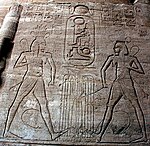November 7th is a significant date in ancient Egyptian history as it marks the unification of Upper and Lower Egypt. This event is also known as the “Two Lands” period, which was the final stage of prehistoric Egypt and directly preceded the unification of the realm1. The conception of Egypt as the Two Lands was an example of the dualism in ancient Egyptian culture and frequently appeared in texts and imagery, including in the titles of Egyptian pharaohs1. The Egyptian title zmꜣ – tꜣwj (Egyptological pronunciation sema-tawy) is usually translated as “Uniter of the Two Lands”1. The unification of Upper and Lower Egypt is depicted by knotted papyrus and reed plants. The binding motif represents both harmony through linkage and domination through containment. The duality is an important part of royal iconography1.

Hapi tying the papyrus and reed plants in the sema tawy symbol for the unification of Upper and Lower Egypt
The unification of Upper and Lower Egypt was not just a political event but also a cultural one. It symbolized the unification of the left and the right, the mind and the heart, and the male and the female1. The union of these opposites was seen as a necessary step towards achieving balance and harmony in the world. This idea of balance and harmony is central to ancient Egyptian culture and is reflected in their art, religion, and philosophy1.
The significance of the unification of Upper and Lower Egypt extends beyond ancient Egypt. It is a reminder that unity and balance are essential for the well-being of any society. The idea of balance and harmony is still relevant today and can be applied to various aspects of life, including politics, economics, and the environment. The unification of Upper and Lower Egypt serves as a reminder that we should strive for balance and harmony in our lives and in the world around us1.
1 Wikipedia, ThoughtCo, Khan Academy, Humanities LibreTexts
